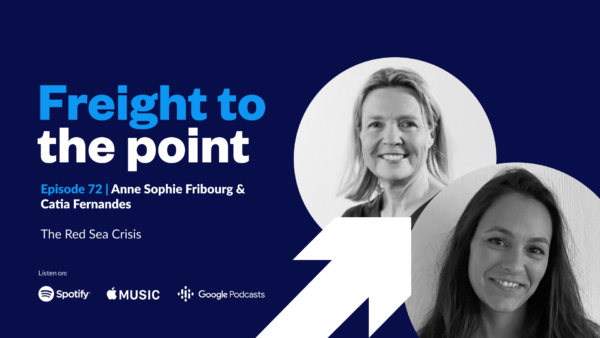Episode 44:
Zencargo's March Ocean Update
See all episodes

Tune into the latest episode of Freight to the Point as we’re giving you another monthly ocean update from the Zencargo team.
Richard Fattal, CCO and Co-Founder at Zencargo and Marina Lennie, Director of Ocean Growth sat together to talk through some of their latest insights for February.
Together, they explore:
- Capacity reduction strategy now vs beginning of the pandemic
- How to approach rates in the current market
- Factors shippers should consider in the coming months
Marina Lennie
Marina Lennie is the Director of Ocean Growth at Zencargo. Marina has over 20 years experience in the shipping space, having worked at MSC for over 10 years. She now leads the pricing team at Zencargo, and is responsible for the company’s pricing processes and strategy.
Richard Fattal
Richard Fattal is Co-Founder and Chief Commercial Officer of Zencargo, the digital freight forwarder enabling organisations to make smarter decisions through real-time data of their supply chain. Based in London, Zencargo helps customers manage their supply chain such as Swoon Furniture and Ribble Cycles.
Resources
Register for the upcoming Rate Strategy Roundtable
A Guide To Fluctuating Demand
Marina Lennie:
Hi and welcome to another episode of Freight to the Point. I’m Marina Lennie Zencargo’s director of Ocean Growth, and today we’ve invited Richard Fattal back on again to talk about what’s happened in the ocean market in the past month. Welcome again, Richard.
Richard Fattal:
Hi, Marina. Thanks so much for having me on again.
Marina Lennie:
So in the last ocean episode you talked to Ann Sophia about the IMO 2023 regulations that were introduced this year and the consequences that they were having. There was the controversial announcement of the split of the 2M alliance and then you discussed whether it was a good time for businesses to tender. So let’s see what’s happening this week. Can you talk us through what’s happened in the last month and how that’s affected the market?
Richard Fattal:
Sure. So towards the end of February we’ve had the reopening post Chinese New Year as factories get back into work and things begin to open up. And what’s been clear is that the supply and demand imbalance continues to drag down rates and there is less cargo than expected emanating out of the far East. I guess all players in the market are really trying to understand the extent to which customers order books will start to flow through over the coming months. But for the moment, there is a real deficit of cargo out of Asia. And this means that the key East-West trades on Asia, Europe and the Trans-Pacific have been weak over this period and that’s actually cascaded down to the rest of the trades around the world, where we see some movements lower in some of the trades that had been more resilient over the past few months.
And to give context in terms of some data points, I would say the market over the past kind of two to four weeks is probably down over 10% and we’re now seeing levels that are more in the context of pre-COVID than anything else that we’ve seen. I would say that one of the things that’s very interesting about the market right now is that people have been talking about the extent to which carriers have been reducing capacity and reducing capacity quickly. But sea intelligence released something that I found particularly insightful and I was having a look at this week, which showed that over the past couple of years there’s been a few moments when the carriers have looked at managing capacity, particularly in the immediate 2020 COVID period when there was a feeling that the COVID pandemic would take a lot of demand out of the system and there was immediate move by the carriers to reduce capacity.
They did a comparison of that period of time and then this period of time over the past kind of four or five months. And what they showed was that in the beginning of the pandemic period, an effective 10% reduction in demand yielded for the carriers are more than 10%, actually as high in some cases as 20% reduction in capacity. What we’ve seen over the past few weeks is the carriers reacting to a 10% reduction in demand with anywhere between a five and 10% reduction in capacity, on a like-for-like basis. And so what you can see from that analysis is that the reaction has not been as quick and as dramatic as at the beginning of the pandemic.
And that might be for a few reasons. One, the carriers in a very different financial position to what they were back then. And so maintaining service for key customers is something that they’re able to do. The other thing is there is maybe a little bit more of a what are the other side, what are the other team going to do, mentality about how they’re approaching the situation. But I guess where on a macro level, the extent of the blank sailings up till now over the past few weeks look very, very severe when you compare them to the immediate period after kind of the discovery of COVID, they don’t look so severe. So that might to some extent explain why we’ve seen so much weakness in the market just now.
What I would say is that the blank sailings continue and so I would very much be watching this space to see how that develops on the market. And we are broadly seeing from carriers that whilst there’s a lot of downward rate pressure in the market, vessels are broadly getting back towards capacity just now.
Marina Lennie:
Yeah, I did hear that, that there’s more and more vessels sailing from the Far East full and warehouses are picking up production and so it does look that we are moving towards a more positive environment than the one we’re in at the moment. So that’s exciting. And interestingly so that you point out that, I mean 30% is huge that to say the capacity that was removed in the COVID time, but also probably related to so much uncertainty. I don’t know if you remember back then, but we were all like, “Oh goodness, what’s going to happen?” Whilst, I guess, there’s more of an element like you say, because they’re able to financially but also more of an element of, well, we sort of are more used to the rollercoaster element and so more comfortable adapting the way we can.
So last time when you to Ann Sophia, we’d only just heard about the 2M split and what it was going to do in the ocean market. We’ve since had a few updates. We’ve heard some of the great speaking at TPM, et cetera. What are the latest updates with regard to the split and what have the carriers started to do?
Richard Fattal:
Yeah, a hundred percent. So I mean, we certainly have seen the 2M carriers adopting new strategies already and reorganizing services as a result of the contract termination. And then thinking also about the differences in their terminal strategies. And so thinking about how their new strategy will fit with their terminal strategy at the same time. And so MSC have planned to relaunch their Asia to the Med Dragon service for March, which will be a standalone service and add some capacity on their front into that market. MSC is going to expand its Sentosa loop out of India into the US, so adding capacity on that market. And that’s a market that a lot of kind of let’s say macroeconomic players are looking at in terms of the extent to which Chinese trade to the US is being substituted into India. And I think that talks to MSC being excited about that trade.
And then MSC have also announced that they’re reworking their cooperations on some of their own vessels. And also a plan to order 10 more smaller 11 and half thousand TEU LNG ships. And so you know, you really see that there’s an almost immediate move by MSC to kind of reshape some of the services as a more standalone carrier. That said, their CEO did say that nothing is off the table in terms of slot sharing agreements. So I think they will look opportunistically at what makes sense from a more independent standpoint.
Of course, we did see over the last few weeks the announcement that Hapag-Lloyd closed one of its own loops from the far east into Europe and went into a slot sharing agreement with CMA, which does show that the 2M kind of move is not something which should be seen in isolation, but as part of a broader reshaping of carrier and alliance dynamics. So it’s really quite interesting to see what will happen. I think one of the things I’ve said in the past is there can be positive and negative dynamics when it comes to customer service. The advantage of an alliance slot sharing agreement is kind of stability on certain loops, large vessel carrier slot sharing agreements that provide kind of regular service point-to-point. The advantage of a kind of reshaped, let’s say more fragmented market is that you have a lot more kind of niche opportunities and different service options from different carriers. So kind of really interesting to see how that shapes out and how it further impacts the market. But definitely, it’s already in motion, from announcement that was just kind of a few weeks ago.
Marina Lennie:
Interesting also for listeners to see the difference between the vessel sharing agreement that really ties you in to have your own vessels on that loop and to really share the space according to whatever’s been established in the contract and the slot sharing agreement where you’re effectively buying space on someone else’s ship, albeit on a regular basis, but that leaves more agility and also more independence for each carrier to then act and maintain their independence. So maybe they’re working also towards something a little more agile and less to that feeling of being stuck. Especially because as we’ve seen, MSC’s fleet has grown hugely, Musk is sort of maintaining its fleet size. So obviously different strategies there and for them to be able to coexist easier probably in a more slot sharing agreement approach rather than the vessel sharing agreement approach. Yeah. But as you say, super interesting. So given, well, all the things, given the couple of topics we’ve covered so far, what are the next steps shippers should take? And especially with regards to rates and what sort of strategies could benefit them considering what’s going on in the market at the moment?
Richard Fattal:
Sure. I mean, there’s no, I guess, clear publicly available information about the cost of running these vessels on these key lanes, but various, I guess, players look to kind of replicate the dynamics of the models and understand both the cost of amortizing the investments in the vessels as well as where they’ve put leases in place and the day-to-day running costs in a new environment, in an environment where there are more regulatory requirements in terms of fuel and in an environment where there’s an eye on complying with IMO regulations and obviously maintaining a level of customer service. And what’s clear is that these levels that we’re now at, both on the Asia, Europe and the Trans-Pacific trade, start to look sort of unsustainable for the carriers in the long-term.
That said, obviously, in a market where providers want to provide long-term offers to their customers, where they want to offer long-term stability and where they want to maintain market share in a competitive market, markets can stay, let’s say at unsustainable levels for periods of time, but they can’t stay there forever. We start to see kind of rate levels which start to put the carrier, a customer dynamic into a position which is more, which makes it more difficult, I guess, for the carrier to offer high degrees of service level at these rates. And we do think that carriers will be looking, some carers will be looking to ensure that they have base cargo at at least these levels and not at lower levels. And that carriers will be adopting, let’s say, more aggressive strategies to try to restrict capacity given where rate levels have got to. And at the same time, that the cargo will eventually come back due to restocking later in the year. Although for the moment, current forecasts look like the real pickup is not going to be until the second half of the year for the moment.
So with that all said, I would say that it starts to become very interesting, and I think I’ve said this before in terms of starting to look at at what point it becomes interesting to say, “OK, now I’d like to have a bit more stability at these levels and to ensure I have space and equipment availability,” and to agree something stable with your service provider. And we really think that actually, that time is probably now and really becomes an opportune moment to at least on a proportion of your cargo to lock in a longer term rate, whether that be on a quarterly basis or on a semi-annual basis, or to some extent on an annual basis. Whilst more capacity is coming into the market over the next two years and we’re waiting for demand to pick up the levels that we’re talking about on ocean freight are ones that are already at historical lows and are at levels which are not incredibly sustainable for the carriers.
So I would say that it starts to be interesting to be able to offer stability back to the service provider, to be able to offer a regular commitment and in exchange to ensure that, you know, you can lock in a certain level of cost of goods sold and stable service over the coming 12 months. So we’re really looking with our customers at what the right agreement is for them, the right agreement is for their different flows, whether those flows are more stable or more seasonal or those flows are more sporadic or regular. But broadly, the picture is a market where levels are really looking, starting to look attractive for long-term contracting.
Marina Lennie:
Yeah, brilliant. And like you were saying, I guess that there was a certain amount of trauma that shippers had, right, about locking in longer term rates and diversifying their rate strategy because of all the things that happened during COVID, pre-COVID, et cetera, and the historical rates in the other direction that we saw. But it’s true that it’s so obvious that it’s not sustainable on the longer term to remain at such low rates that even if you are looking at maintaining some diversity, that proportion of things that you park on the longer-term rate does look like it should be increased.
Richard Fattal:
Yeah. A hundred percent. And just to point to the diversification, I would say certainly it’s a year where as a function of the kind of active capacity management strategies of the carriers, some diversification is necessary because if you need to maintain weekly sailings or you need to maintain a banded transit time, you may need to certainly have a backup strategy for your more sensitive cargo. And I would encourage you to really think about that in terms of your contracting strategy. But I would say that carrier reliability is up, lead times are down, and so the extent to which you can lock in regularity of service and a stable rate agreement for the majority of your cargo really becomes relatively more attractive than it’s historically been over the last year or two. And around the edges, a more diversified strategy becomes interesting to protect against the realities of a market where there are a lot of blank sailings.
Marina Lennie:
Very wise words. So we are coming up to time, but lastly for all our listeners, is there anything else that they should be aware of in today’s market?
Richard Fattal:
Oh, I mean, so one thing that’s come up just recently is the resurgence of the ILWU labor talks, the negotiations between the Longshore and Warehouse Union and on the US west coast. And there’s been increasing pressure to complete the new contract negotiations because a lot of people have attributed the shift of volumes from the west to the east coast because of risk and fear around potential labor union issues and strikes and disruption. And also to some extent, because of relative differences in port congestion between the west and east coast.
A lot of market players are saying that some of those flows are kind of long-term shifts and, you know, you have seen, for example, carrier investments into the east coast ports and more and more interest in general in the east coast of the US as a strategic route into the US. A lot of relocation of warehouses as well by players in order to have a diversified East-West strategy and to get to their customers faster. But those union talks are definitely on our radar. I would say that we don’t think that there’s going to be likely disruption over the coming weeks, but it’s certainly something I would encourage everyone to look out for and to watch closely should there be any issues there. And it’s certainly something that your service providers can advise you on in regards to alternative routing strategies should an issue a arise.
Marina Lennie:
Yeah, so interesting and historically as well, because last time the labor negotiations took place, there was so much congestion and so many days of waiting, and it was prior to COVID obviously, but there was still a huge amount of trauma, I think, related to all of that. So huge consequence there on the mapping of the logistics in the US. Well, so diversification definitely on the cards both for on the shipper side and on the carrier side. So looking forward to our next chat to see what’s happened.
So thanks again to all our listeners for tuning into this episode of Freight to the Point. Don’t forget to like and subscribe to our show. And if you have any feedback on this episode, please don’t hesitate to reach out on LinkedIn. So until our next episode, goodbye. Thanks again, Richard, and see you also.

Episode 72: The Red Sea Crisis
In the latest episode of Freight to the Point, we’ve featured our most rec...

Episode 71: The potential of demand forecasting with artificial intelligence
In the most recent instalment of Freight to the Point, Lucie Phillips, Zen...

Episode 70: Rates: What's next for 2024?
As we prepare for the year ahead, it's crucial to consider the three pillars...

